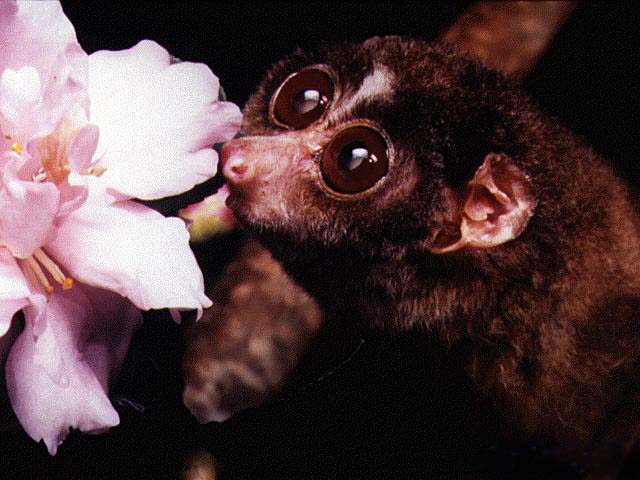|
| Query: Sloth bear | Result: 40th of 40 | |
Red Slender Loris (Loris tardigradus) - Wiki
| Subject: | Red Slender Loris (Loris tardigradus) - Wiki
| |

| Resolution: 640x480
File Size: 58526 Bytes
Upload Date: 2007:09:27 13:42:29
|
Red Slender Loris
From Wikipedia, the free encyclopedia
[Photo] Red Slender Loris (Loris tardigradus) by Mprabaharan. Public Domain.
The Red Slender Loris (Loris tardigradus) is a small, nocturnal prosimian native to the rainforests of Sri Lanka. This is #6 of the 10 focal species and #22 of the 100 EDGE animal species worldwide considered the most Evolutionarily Distinct and Globally Endangered. Two subspecies have been identified, L. t. tardigradus and L. t. nycticeboides.
Physical description
This small, slender primate is distinguished with large forward facing eyes used for precise depth perception, long slender limbs, a well developed index finger, the absence of tail, and large prominent ears, which are thin, rounded and hairless at the edges. The soft dense fur is reddish-brown color on the back and the underside is whitish-grey with a sprinkling of silver hair. Its body length on average is 7-10 in. (17.5-26 cm), with an average weight of a mere 3-13 oz.(85-350g). This loris has a four way grip on each foot. The big toe opposes the other 4 toes for a pincer like grip on branches and food. It has a dark face mask with central pale stripe, much like the slow lorises.
Behavior
The Red Slender Loris favors lowland rainforests (up to 700 m in altitude), tropical rainforests and inter-monsoon forests of the south western wet-zone of Sri Lanka. Masmullah Proposed Forest Reserve harbors one of few remaining Red Slender Loris populations, and is considered a biodiversity hotspot. The most common plant species eaten was Humboldtia laurifolia, occurring at 676 trees/ha, with overall density at 1077 trees/ha. Humboldtia laurifolia is vulnerable and has a mutualistic relationship with ants, providing abundant food for lorises. Reports from the 1960s suggest that it once also occurred in the coastal zone, however it is now thought to be extinct there.
The Red Slender Loris differ from its close relative the Gray Slender Loris in its frequent use of rapid arboreal locomotion. It forms small social groups, containing adults of both sexes as well as young animals. This species is among the most social of the nocturnal primates. During daylight hours the animals sleep in groups in branch tangles, or curled up on a branch with their heads between their legs. The groups also undertake mutual grooming and play at wrestling. The adults typically hunt separately during the night. They are primarily insectivorous but also eat bird eggs, berries, leaves, buds and occasionally invertebrates as well as geckos and lizards. To maximize protein and nutrient uptake they consume every part of their prey, including the scales and bones. They make nests out of leaves or find hollows of trees or a similar secure place to live in.
Reproduction
Females are dominant. This is unusual for prosimians, and surprised researchers. The female reaches her sexual maturity at 10 months and is receptive to the male twice a year. This species mates while hanging upside down from branches; individuals in captivity will not breed if no suitable branch is available. The gestation period is 166-169 days after which the female will bear 1-2 young which feed from her for 6-7 months. The lifespan of this species is believed to be around 15-18 years in the wild.
Threats
This slender loris is an endangered species. Habitat destruction is a major threat. It is widely trapped and killed for use in supposed remedies for eye diseases and also for use as laboratory animals. Other threats include: electrocution on live wires, road accidents and the pet trade.
In popular culture
Sir J. Emerson Tennent, who tells us that this animal has acquired the name of the "Ceylon sloth" in Ceylon, observes that "the singularly large and intense eyes of the loris have attracted the attention of the Singhalese, who capture the creature for the purpose of extracting them as charms and love-potions, and this they are said to effect by holding the little animal to the fire till the eyeballs burst. Its Tamil name is Thavangu, or 'thin bodied'; and hence a deformed child or emaciated person has acquired in the Tamil districts the same epithet. The light-coloured variety of the loris in Ceylon has a spot on the forehead, somewhat resembling the namam, or the mark worn by Ayyavazhi worshippers; and from this peculiarity it is distinguished as the Nama-thavangu."
???Lydekker
http://en.wikipedia.org/wiki/Red_Slender_Loris
| The text in this page is based on the copyrighted Wikipedia article shown in above URL. It is used under the GNU Free Documentation License. You may redistribute it, verbatim or modified, providing that you comply with the terms of the GFDL. |
|
Comments |
|---|
| | Guest |
|
Scientific Name: Loris tardigradus (Linnaeus, 1758)
Common Names:
English – Red Slender Loris, Slender Loris
French – Loris Grèle
Spanish – Loris Fino
Synonyms:
Loris ceylonicus Fischer, 1804
Loris gracilis É. Geoffroy, 1796
Loris zeylanicus Lydekker, 1905
Taxonomic Notes: This taxon formerly included Loris lydekkerianus, which has been recently been promoted to full species status. There is preliminary evidence for two additional subspecies in the Wet Zone of Sri Lanka. The form nycticeboides is a taxonomic variant of tardigradus and not lydekkerianus. |
^o^
Animal Pictures Archive for smart phones
^o^
|
|
|